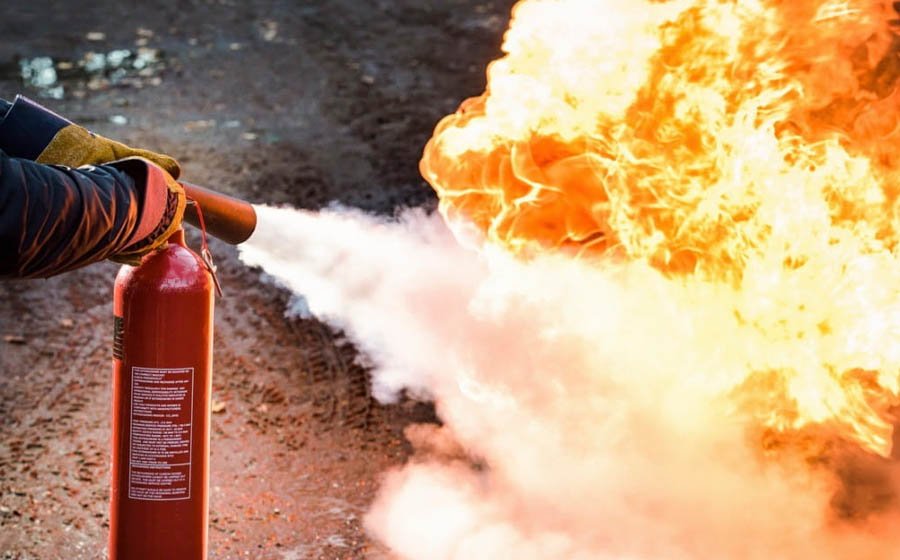You have probably come across a fire extinguisher where you work, at home, or in a public service vehicle- but have you ever wondered how it works, how to use it, or what it’s made of? If your answer is no, this might lead to unthinkable consequences if a fire breaks out.
Luckily, you have clicked on the right page to inform you all there is to know about fire extinguishers. To make it easier for you, we will systematically break down this topic into different categories and drive the main point home.
Table of Contents
Types of fires
In some countries like the US, fires are classified into different categories, the more common being A, B, and C. Class A fires include day-to-day materials that easily and quickly burn, like plastics, papers, or clothes. Flammable liquids cause class B fires, for example, solvents, gasoline, alcohol, and more.
In contrast, class C fires are caused by electrical devices plugged into live electrical circuits, i.e., computers, consoles, electrical heaters, televisions, etc. Fire extinguishers are designed to counter different classes of fires, the most ordinary being the multipurpose dry chemical extinguisher.
Dry chemical Fire extinguishers
Dry chemical fire extinguishers are called ABC fire extinguishers and mostly feature portable ones. The fine yellow powder consists of Monoammonium phosphate and nitrogen. In addition, a fine layer of H2P2O6 forms on the smoldering surface, cutting off the air supply and putting out the fire. Cooling is achieved by the water vapor generated within the flame zone.

In addition, the dry chemicals also counter the chemical reaction of fire, making these extinguishers exceptionally great at stopping fires. Nitrogen works as a pressurizer and propellent when expelling the powder.
Though extinguishers are safety equipment against fire, necessary precautions should be taken. Inhaling sodium bicarbonate and Monoammonium phosphate Inhalation of Monoammonium phosphate and sodium bicarbonate can lead to mild irritation of the lungs, nose, and throat. These mild irritations can cause symptoms like dizziness, mild headaches, shortness of breath, and coughing.
The symptoms might not be severe, but they can greatly tip the successful outcome of putting out a fire. However, the symptoms usually go away quickly after inhaling fresh air. To avoid these symptoms, understanding the proper way to use ABC dry chemical extinguishers is imperative.
ABC dry chemical fire extinguisher safety and use
If used correctly, an extinguisher can prevent damage to property and save lives by combating small fires. Fires spread and grow quickly; therefore, the residents must get out safely to avoid unnecessary harm or injury. After the affected room has been cleared, you can now attempt to put out the fire using a dry chemical extinguisher by following the below-provided steps:
Step 1
Different types of fire require different approaches to put out the fire effectively. Most fire extinguishers can be mounted on the wall behind a glass case where it’s visible to everyone in the room.
If it’s behind a glass case, break it and remove the extinguisher. Begin by pulling out the safety pin, which will rip the tamper seal and allow the nozzle to expel the contents. Hold the lever with one hand while the other holds the nozzle for aim. Here are some basic tips on how to aim the extinguisher:
- Solid Materials: Move across the fire while aiming the nozzle at the fire’s base.
- Spilled liquids: Point the nozzle close to the edge of the flame, then quickly spray, using a sweeping motion, the fire away from it until all embers are extinguished.
- Flowing liquid: Point the nozzle at the fire’s base and spray upwards using a sweeping motion.
- Burning gas: Cut off the gas supply as quickly as possible! To put out the fire, point the nozzle at it and spray.
- Electrical equipment: Turn off the electricity only if it’s safe. Point the nozzle directly at the flames and spray.
Step 2
After you put out the fire, carefully search the area for any chance of re-ignition, for this is possible if not correctly extinguished. Also, fire spreads quickly, and there can be a chance it might have spread to other parts without your knowledge. Once done, displace the fire extinguishers in your bin or contact the nearest fire department to see if they offer refill services.
Conclusion
ABC dry chemical extinguishers are perfect for Class A, B, and C fires; however, they can also be used in other ways. It’s important to note that portable fire extinguishers can only combat small fires.
If you decide to fight the fire, please keep a safe distance and adhere to the guidelines above. If the fire has spread, do not attempt to put it out; instead, escape immediately and alert nearby residents before calling the fire and rescue department.










